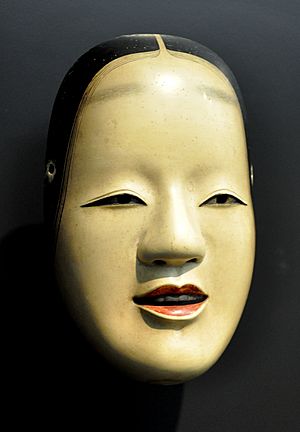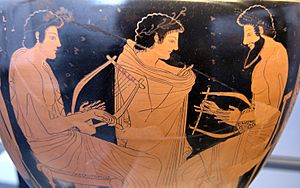Intangible cultural heritage facts for kids
An intangible cultural heritage (ICH) is a special kind of cultural heritage. It includes practices, ideas, skills, and traditions. These are things that people do or know. UNESCO sees them as important parts of a place's culture.
Unlike buildings or old objects, intangible heritage cannot be touched. It is like folklore, customs, beliefs, and language. It also includes skills and traditions. In 2001, UNESCO started to define this type of heritage. They created the Convention for the Safeguarding of the Intangible Cultural Heritage in 2003. This helps protect and promote these important cultural elements.
Contents
What is Intangible Cultural Heritage?

The Convention for the Safeguarding of the Intangible Cultural Heritage explains ICH. It includes practices, ways of showing things, and skills. These also involve tools, objects, and special places. Communities, groups, and sometimes individuals see them as part of their culture.
This heritage is often called "living cultural heritage." It shows up in many ways, such as:
- Stories and sayings, including language. Language is a key part of intangible heritage.
- Performing arts like music, dance, and theater.
- Social practices, rituals, and festive events.
- Knowledge about nature and the world.
- Traditional crafts and skills.
Cultural heritage is all the products and processes of a culture. These are kept safe and passed down through generations. Some heritage is physical, like buildings or art. But many parts of culture are intangible. These include songs, music, dances, and skills. Cooking, crafts, and festivals are also examples.
You cannot touch or store these cultural forms in a museum. You can only experience them. The UN calls people who carry these traditions "Human Treasures." Protecting languages is also very important. Languages are a huge part of intangible cultural heritage.

The 2003 Convention says that ICH is key to cultural diversity. It helps keep creativity alive. It is defined as:
"Intangible Cultural Heritage means the practices, ways of showing things, knowledge, and skills. This also includes the tools, objects, and places connected to them. Communities, groups, and sometimes individuals see these as part of their cultural heritage. This heritage is passed from one generation to the next. It is always being remade by communities. This happens as they respond to their environment, nature, and history. It gives them a sense of who they are and helps them feel connected to the past. This promotes respect for different cultures and human creativity. For this Convention, only intangible cultural heritage that respects human rights and mutual respect among groups will be considered."
Food and Dance Heritage
More and more food-related traditions are being added to UNESCO's lists. This is because sustainable development is a big focus. Examples include the Mediterranean diet, traditional Mexican cuisine, and Japanese washoku.
UNESCO's lists also include many dance styles. These often involve singing, music, and celebrations. Some are ritual dances, like Ma'di bowl lyre music from Uganda. Others are social dances, like Cuban rumba. Some dances are mainly practiced in their home country. An example is Sankirtana from India.
Other dance forms are enjoyed worldwide. For example, flamenco from Spain and tango from Argentina and Uruguay are global. Dance combines many elements. It includes culture, traditions, body movement, costumes, and music. This makes it a complex but interesting type of heritage to protect.
Digital Heritage
Digital heritage is a newer part of Intangible Cultural Heritage. It means using digital media to save cultural or natural heritage. It is how heritage is shown in the digital world.
How is it Passed On?
-
A Greek polyphonic group from Dropull.
Intangible cultural heritage is often passed down by word of mouth. It is shared within a community. While some people are known for carrying traditions, ICH is usually bigger than one person's skills.
A report from Newfoundland and Labrador in 2006 talked about oral culture. It said that "Each member of the community has a piece of the shared knowledge. Important knowledge is passed on during community activities. This often happens without anyone even thinking about it." This shows how natural the process of passing on ICH can be.
Protecting Intangible Heritage
Before the UNESCO Convention, many countries worked to protect their intangible heritage. Japan was the first country to make laws for this. Their 1950 law protected both physical and intangible culture. They named "Important Intangible Cultural Properties." They also recognized "holders" of these traditions. These people are informally known as Living National Treasures.
Other countries have started similar programs. These include South Korea, the Philippines, Ukraine, and France.
In 2003, UNESCO adopted the Convention for the Safeguarding of the Intangible Cultural Heritage. This started on April 20, 2006. The Convention suggests that countries make lists of ICH in their areas. They should also work with the groups who keep these traditions alive. This helps make sure the traditions continue.
UNESCO also collects money from its members. This money is used to support recognized ICH. UNESCO also created other programs. One was called Proclamation of Masterpieces of the Oral and Intangible Heritage of Humanity. This list started in 2001 with 19 items. More were added in 2003 and 2005. This list helped balance the World Heritage List. That list mostly focused on physical monuments. In 2008, this list was replaced by the UNESCO Intangible Cultural Heritage Lists.
Countries and Their Heritage
Many countries have their own lists of cultural heritage. These are not always on UNESCO's lists.
| Rank | Country | Number of Intangible Cultural Heritage elements inscribed by UNESCO |
|---|---|---|
| 1 | 43 | |
| 2 | 26 | |
| 3 | 22 | |
| 5 | 20 | |
| 6 | 18 | |
| 4 | 21 | |
| 7 | 15 | |
| 8 | 14 | |
| 9 | 13 | |
| 10 | 12 | |
| 11 | 11 | |
| 12 | 10 | |
| 13 | 9 | |
| 14 | 8 | |
| 15 | 7 | |
| 16 | 5 | |
| 17 | 4 |
See also
 In Spanish: Patrimonio cultural inmaterial de la Humanidad para niños
In Spanish: Patrimonio cultural inmaterial de la Humanidad para niños
- Living human treasure
- Non-material culture
- UNESCO Intangible Cultural Heritage Lists




